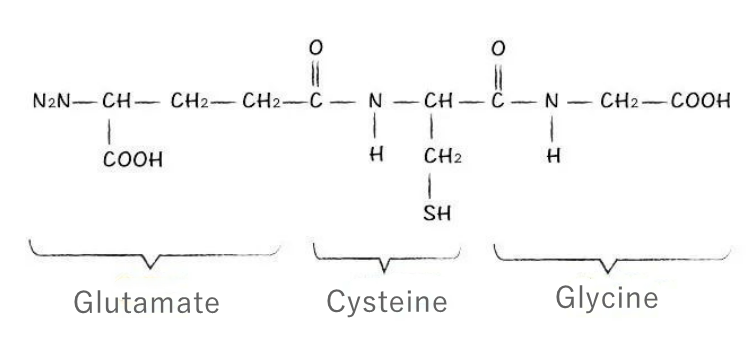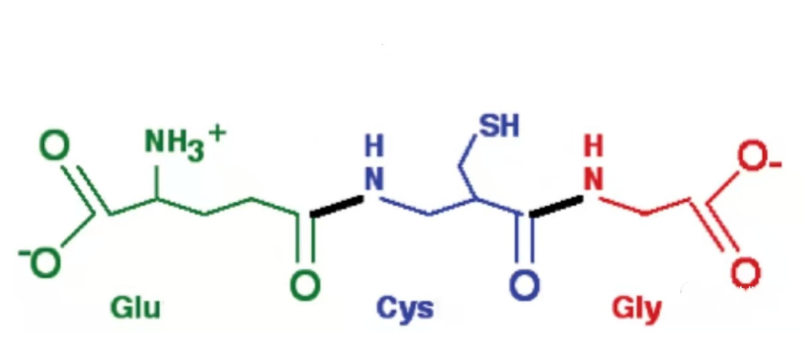What is L-glutathione?
Glutathione is a naturally occurring molecule in the human body and is composed of three amino acids, cysteine, glutamate, and glycine. It is found naturally in all the cells of the body, certain fruits and vegetables, fungi and some bacteria. Glutathione is involved in many different processes, including detoxification and fighting off infections. It serves a variety of important roles in the body, including protecting cells from oxidative damage, detoxifying harmful substances like heavy metals, helping to regulate enzyme function, aiding in the formation of proteins, and maintaining the immune system. It’s also an important antioxidant that can help protect your cells from damage.
Glutathione can be divided into reduced glutathione ( GSH, or L-glutathione), which is the active form and oxidized glutathione (GSSG), the inactive state, which can be converted into each other. Among them, reduced glutathione is the active form, which accounts for the most under physiological conditions, about 95%, and has a high free radical scavenging rate. The glutathione we are talking about in this article is actually reduced glutathione. Here’s what you need to know about L-glutathione.
Is Glutathione the same as L-Glutathione?
L-Glutathione and Glutathione are two compounds that are often confused with one another. L-Glutathione is an antioxidant found in human cells, while Glutathione is a protein also found in human cells. The difference between these two compounds is their molecular structure; L-Glutathione has three peptide bonds and Glutathione has four peptide bonds. The “L” in “L-glutathione” refers to the specific stereoisomer of the molecule, which is the biologically active form.
The structure of Glutathione
Glutathione (5-L-Glutamyl-L-cysteinylglycine) is synthesized by glutamate-cysteine ligase (GCL) and glutathione synthase (GSS). It is a tripeptide containing gamma-amide bond and sulfhydryl group. It is widely distributed in the cells of mammals, plants and microorganisms. Unlike other peptides, one of the peptide bonds of glutathione (GSH) is formed between the gamma-carboxyl group of glutamic acid and the amino group of cysteine. GCL is the cause of this special peptide bond of glutathione. It first connects the gamma-carboxyl group of glutamic acid to the amino group of cysteine to form the precursor of GSH, gamma-glutamylcysteine. The GSS then attaches glycine to it. So the GSH is created.
The structure of glutathione contains a lively sulfhydryl (-SH), for glutathione active group (, easy to combine with some drugs (such as paracetamol), toxins (such as free radicals, iodoacetic acid, mustard gas, lead, mercury, arsenic and other heavy metals), and has integrated detoxification. In addition, it also has powerful antioxidant, immune system maintenance and other functions.
The manufacturing process of L-glutathione powder
Glutathione is widely present in all animal and plant cells. In 1921, scientist Frederick Gowland Hopkins(1861-1947) discovered that the substance was self-oxidizing and contained glutamic acid and half acyl acid, so it was renamed glutathione. At present, glutathione has been produced on an industrial scale in the way of fermentation and enzyme catalysis processes. Microbial fermentation is a common method for industrial production and most of the microorganisms that produce glutathione are yeast and Escherichia coli. The process has the characteristics of high safety, low cost and high purity. At Rainbow biotech, we are using glucose as raw material and yeast metabolism, thus get more pure and more economical L-glutathione powder. Here is a comparison of the fermentation and enzymatic process of GSH.
| Specification | Fermentation Method | Enzyme Catalysis | |
| Assay(%)(Titrant Method) | >98.5 | 98.0 | |
| Assay(%)(HPLC Method) | >99 | 97.4 | |
| Related Substance(%) | L-glutathione oxidized | 0.1~0.2 | 0.3 |
| Cysteine | 0.05 | 0.2 | |
| L-γ -glutamyl-L-cysteine | 0.2~0.4 | 0.3 | |
| L-cysteinyl glycine | Not detected | <0.05 | |
| Single Unknown
Impurity |
0.08 | 0.1 | |
| Total Impurities | 0.6~0.8 | 1.1 | |
| Shelf Life | 3 years | 2 years | |
The biological function of L-Glutathione
L-Glutathione is s powerful antioxidant
Antioxidants are important nutrients that help protect our cells from damage caused by free radical molecules. Glutathione is a powerful antioxidant that helps protect the body from free radical damage and fight oxidative stress. Free radicals can cause oxidative stress and damage, leading to various health problems including cancer and cardiovascular disease. Glutathione works by neutralizing these free radicals, preventing them from causing any further damage. Research suggests reduced L-Glutathione can help prevent oxidative damage to cells, reduce inflammation and may contribute to longevity.
Glutathione reduces oxidative stress by helping to regulate the redox state of your cells. Oxidative stress is caused by an imbalance between the production of reactive oxygen species (ROS) and your body’s ability to prevent them from harming you. Too much ROS can cause damage to important cellular components, leading to a number of diseases such as cancer, rheumatoid arthritis, and heart disease. This can help protect the mitochondria, which are responsible for energy production in all of your cells. L-Glutathionecan be used to maintain proper immune function and aid in detoxification processes, which contributes to its powerful antioxygenic property.
L-Glutathione helps detoxify your body
GSH can weaken and get rid of harmful toxins from the body. It can directly combine with toxic substances to make them excreted from the body, or it can indirectly remove toxic substances by increasing the activity of two enzymes, GSH-Px and GST, and finally weaken or eliminate the influence of toxic substances on the body. It also assists in detoxifying chemicals, including those that your body produces naturally and pollutants and drugs. Detoxifying your body is an important part of overall health and nutrition, so helps to purify your body by ridding it of potentially harmful toxins and increasing the efficiency of all its other processes.




